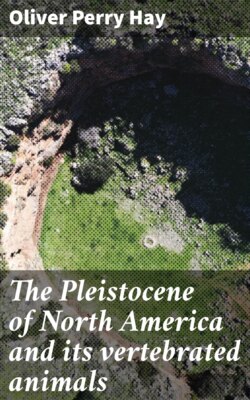Читать книгу The Pleistocene of North America and its vertebrated animals - Oliver Perry Hay - Страница 55
ONTARIO.
Оглавление(Map 5.)
1. Essex County.—In 1898 (Science, n. s., vol. VII, p. 80), Dr. H. M. Ami reported that he had exhumed some mastodon remains in this county. The exact locality was not given. It was north of the west end of Lake Erie. The section dug up was from 6 to 8 feet deep. At the bottom were clay and boulders; above this were found gravel and the bones, and above these sand, shell marl, peat, and other sands of various colors. The remains were fragmentary.
2. Morpeth and Highgate, Elgin County.—In 1858 (Canad. Jour. Indust. Sci. Art, ser. 2, vol. III, p. 356), E. J. Chapman announced the discovery of a tooth of mastodon at or near this place. He had seen a drawing of the tooth. It appears that another man also had sent to the journal an account of the discovery, accompanied by drawings. These showed 5 distinct crown-ridges.
In 1891 (Geol. Mag. London, ser. 3, vol. VIII, p. 504; Brit. Assoc. Adv. Sci., 64th meeting, 1892, p. 654), Professor J. Hoyes Panton gave an account of the discovery of mammoth and mastodon bones at Highgate, only a few miles north of Morpeth. These were found in a bed of marl. Some measurements of the mastodon were given.
3. St. Thomas, Elgin County.—In a private museum at Niagara Falls, owned at the time by Davis Brothers, the writer saw a quite complete lower jaw and a tusk, labeled as having been found at this place in 1856, on the farm of Isaac Barnard. The jaw had the last 3 teeth on the right side and the last 2 on the left side. In front was a tusk about 6 inches long which appeared to be in the middle of the jaw. The upper tusk is curved in a semicircle. Dr. J. W. Dawson (Geol. Mag. London, ser. 1, vol. VI, 1869, p. 39) mentions this find. He stated that there were 2 lower tusks. If this was the case the species M. progenium is indicated.
4. London, Middlesex County.—In the article quoted above from the Geological Magazine of London, Dr. J. W. Dawson stated that there were in the Provincial Museum 3 mastodon molars which had been found at London.
5. Marburg, Norfolk County.—In 1898 (Science, n. s., vol. VII, p. 80), Dr. H. M. Ami reported the exhumation of remains of a mastodon at some place in this county. The skull, 25 ribs, 40 foot-bones, 2 tusks, and many vertebræ were recovered. The remains were buried at a depth of from only 3 to 4.5 feet. At the bottom was clay; above this, shell marl, and sands of different colors; and above all was peat.
The writer has seen this skull in Victoria Museum, Ottawa. It is to a considerable extent restored. It appears to have been found at or near Marburg. A small label, somewhat injured, has the record: “West half lot 15, R V, Tp. of [?]dhouse, Norfolk Co., Ont. Ami, 1897.” The penultimate and ultimate molars are in place. The former is 113 mm. long; the latter is 174 mm. long, and has 4 crests and a talon. The tusks are present and the right one is 2,230 mm. long. The skull is a large one. The width across the rear is 760 mm.
6. Dunnville, Haldimand County.—In 1869 (Geol. Mag. London, dec. 1, vol. VI, pp. 38, 39), Dr. J. W. Dawson gave an account of the finding of a mastodon, in 1868, at the place named, situated at the east end of Lake Erie. When he reached the place a large part of the animal had disappeared, especially the tusks. He found 7 teeth, a few vertebræ, a few fragments of ribs, and part of the right ramus of the lower jaw. These remains were buried in a swamp, partly embedded in a layer of fine sand. This contained fresh-water shells of species yet living in that region. The sand was 2.5 feet thick and rested on boulder clay. Over the sand was 1.5 feet of black vegetable mold. He regarded it as clear that the animal lived long after the close of the Glacial period.
7. St. Catharines and Welland Port, Lincoln County.—At Rochester University, New York, the writer has seen a cast of a lower jaw, labeled as having come from the place named above. On the left side the second and third molars are present, the former slightly worn, the hindermost not at all. On the right side the hindermost molar is not to be seen. The second molar is tilted up behind and lowered in front. The little wear of the tooth is on the hinder end. It is possible that the hindermost molar was yet in the bone and somewhat under the second one. The ramus has a length of 400 mm.
8. Toronto, York County.—It does not appear to be wholly certain that the mastodon has been found at Toronto; but its occurrence there is probable. In some of his papers Coleman has reported that its presence was believed to be determined.
9. Junction of Missinaibi and Moose Rivers, Algoma County.—In 1898 (Science, n. s., vol. VII, p. 80), Robert Bell reported a mastodon tooth from the locality mentioned. It had been chopped out of a skull by an Indian. Later Bell attempted to obtain the skull, but could not, because of high water. A further account was given of this tooth by Bell in 1898 (Bull. Geol. Soc. Amer., vol. IX, p. 383).
